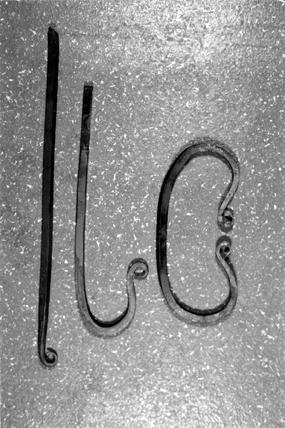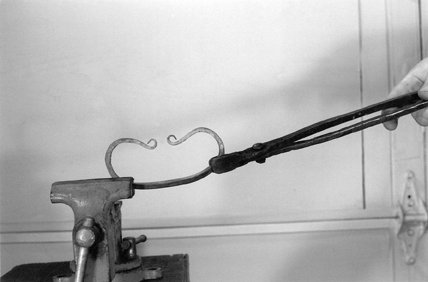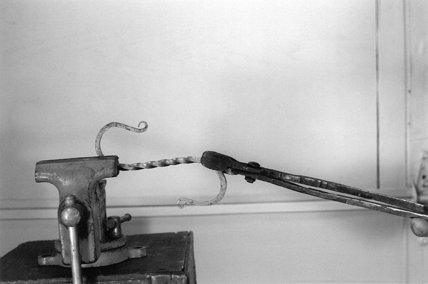Published in the February 2001 Issue of Anvil Magazine

As a demonstrating blacksmith, I am always looking for a new item that will hold a traverler's attention. In this age of television, radio and rapid-fire sound bytes, people have become impatient. It is not enough to make something unique or completely by hand; we must also spin a good yarn or two while we work. Image 1: Stages of Hook Making Some years ago at the Southern California Renaissance Pleasure Faire I had a small booth with an adjacent work area. The project in production was a small one-piece knife that was elegant and easy to sell. I made at least 100 of them in the eight weeks of the Faire. All were done by hand, quick and dirty, but with no power tools of any kind. The wildly attractive young lady who circulated through the crowd showing the finished results was a powerful sales person who knew how to close a deal. Through all this, we kept up a lively conversation with as many customers as we could engage. They loved it. It was the stories they took with them that made the knife a part of the experience. One customer came back a few weeks later with a friend to see the demo. They both laughed at the same jokes and his friend bought a knife. The first customer bought another knife as a gift for a friend and videotaped the demo for himself and as a part of his gift. A good apprentice is a boon here. That person can pick up the pace during the moments when concentration is required by the smith, then fade back when the smith goes back to chatting. It keeps the hook in place and the crowd involved. "Speaking of Hooks..." A small project such as the S hook (see figure 3) is one of the best projects for short demonstrations. It is easy to make, takes little time and affords a lot of opportunity for pleasant banter. This is where you explain how important the S hook is to every aspect of day-to-day living. They can be used to regulate the height of a pot from the fire or hang things in the hearth to be dried. Joints of meat are hung from S hooks while they age. So useful is the S hook that you make one or two whenever you can spare the time. I use 1/4" square stock for most of these, but hexagonal stock makes a really nice hook, as well. The first step is to place the end of an 8-inch section of stock into the coals and gently raise the heat while asking if anyone in the crowd has any knowledge of the work of the blacksmith. Prepare to be astounded at the results. Most will not say anything, but someone is sure to say that they put shoes on horses. Perhaps one in the crowd will say that they make things of metal.
Image 2: The C Hook I like to tell them that we work iron. I hand them a pair of tongs and tell them that we are one of the few crafts that make their own tools. I tell them, "We make them from iron, the black metal. We strike the iron to form it, we smite it, thus the word smith. The coppersmith strikes copper; we strike the black iron." At this time, I have been drawing the hot end of the stock to a long, sharp point on the edge of the anvil and have placed the thin point back in the fire for a second or two. I then round that point over the anvil's edge into a small, graceful curl. One thing I like to relate to the crowd is that being a blacksmith is a long and difficult road. It requires a long period of study and great skill. It was not my first choice of professions, however. My first choice was "Wealthy Landowner," but that guild was closed, and so I felt this was my second-best opportunity. This curled end is placed in the fire and a couple of strokes taken on the bellows, whipstaff, or whatever is used to supply an air blast to the forge where I am working. The curled end is placed in the cold water of the quench barrel. This cools and hardens the curl so it will not deform as the hammer is used to gently tap the end of the piece into a curve. Now the opposite end of the stock is worked in the very same way. First a long taper. Then the taper is rolled into a curl. All this time there should be a constant stream of chatter to our audience, for audience is what they have become. They are not just listening to my jokes and flirtations. (You have been flirting with your customers, haven't you?) They have been listening to descriptions of how the work is done. I give them lots of information about our work-the jokes and antics are just fillers. I tell the crowd what kind of hammer I am using and why. I show them how tongs should fit the work. I explain what I use for fuel and why. I like to name the parts of my tongs and relate how they got those names. All of this is important and lends credibility to the blacksmith's status as a respected member of the community. During all this banter is when I set myself up. The opposite end of the hook is bent-not into an S, but a C. Ooops!
Image 3: Shaping the S Hook I now begin bragging on what a wonderful, simple invention the S hook is, and hold it up to the crowd. The audience is at first embarrassed for me and then begins to giggle. "Oh, my...er, I seem to have...well, the C hook is nearly as useful. Many believe it to be superior." By now they are very amused. I silently place the back of the C into the fire and address the audience, "As I was saying earlier, this is a very difficult craft to master. Even one skilled in the art can make a mistake if he does not concentrate on the task at hand." More giggles, nudgings and laughter. This will usually engender several clever remarks that are tossed in my direction. I then say: "Knowing how to turn an error into good work can mean the difference between success and failure in your life." I remove the C from the fire and place one end in the jaws of the vise. With the tongs I firmly grip the other end and begin to twist. One and a half turns put the S shape nicely into place. One or two taps with a hammer flatten the ends and place everything in line. I then plunge the piece into the cold water and offer it to the crowd, still held in the jaws of my tongs. "When life gives you lemons, learn to make lemonade." It is an old saw but true, nonetheless. Usually no one wants to touch the piece. I always laugh and say that I would never offer anyone hot iron. I take the piece in my fingers to be sure it is cold to the touch and offer it to anyone who will take it in their hands. Keep them interested and the same crowd will stay with you from start to finish. Making artifacts of iron for a crowd is one of the most enjoyable and rewarding things I have ever done. Seeing the looks of astonishment on the faces of the young or watching older people who remember seeing things like this when they were young is a reward beyond price. Captions 1. Stages of Hook Making 2. The C Hook 3. Success: Shaping the S Hook |

